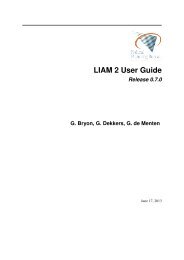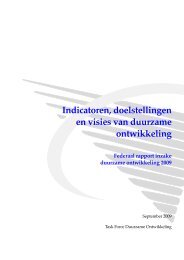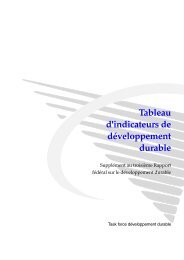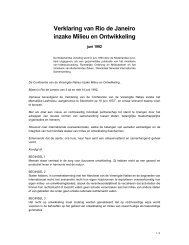long-term care use and supply in europe: projections for germany ...
long-term care use and supply in europe: projections for germany ...
long-term care use and supply in europe: projections for germany ...
Create successful ePaper yourself
Turn your PDF publications into a flip-book with our unique Google optimized e-Paper software.
LONG-TERM CARE USE AND SUPPLY IN EUROPE | 5<br />
variables that strongly <strong>in</strong>fluence <strong>in</strong>stitutionalisation rates <strong>and</strong> that are available <strong>for</strong> the countries<br />
<strong>in</strong>cluded <strong>in</strong> our study. Specifically, we consider:<br />
- Age<br />
- Gender<br />
- Severity of functional impairment<br />
- Cognitive impairment (dementia)<br />
- Income<br />
- Educational atta<strong>in</strong>ment<br />
- Number of comorbidities<br />
The ma<strong>in</strong> drivers of <strong>in</strong>stitutionalisation of elderly people are age <strong>and</strong> severity of functional impairment.<br />
Both are strongly l<strong>in</strong>ked with the dem<strong>and</strong> <strong>for</strong> <strong>care</strong> services; a high dem<strong>and</strong> <strong>for</strong> <strong>care</strong> could necessitate<br />
<strong>in</strong>stitutionalisation if <strong>in</strong><strong>for</strong>mal <strong>care</strong> is not sufficient <strong>and</strong> if <strong>for</strong>mal <strong>care</strong> <strong>in</strong> the community is too costly or<br />
unavailable. When possible, the severity of functional impairment is captured by the number of<br />
limitations <strong>in</strong> activities of daily liv<strong>in</strong>g (ADL) 1 .<br />
The dem<strong>and</strong> <strong>for</strong> <strong>care</strong> services is correlated with two other variables: number of comorbidities <strong>and</strong><br />
cognitive impairment. The number of ADL limitations does not precisely capture <strong>care</strong> needs <strong>for</strong> elderly<br />
people suffer<strong>in</strong>g from dementia beca<strong>use</strong>, when cognitive impairment becomes severe, people with<br />
dementia often require permanent supervision, which can necessitate <strong>in</strong>stitutionalisation if such <strong>care</strong> is<br />
not available <strong>in</strong> the community. For any number of functional impairments, cognitive impairment a<br />
priori <strong>in</strong>creases the probability of <strong>in</strong>stitutionalisation. In the same way, the number of comorbidities is<br />
expected to positively <strong>in</strong>fluence the likelihood of <strong>in</strong>stitutionalisation beca<strong>use</strong> the burden of <strong>care</strong> <strong>in</strong> the<br />
community is higher when elderly people suffer from comorbidities.<br />
Choos<strong>in</strong>g <strong>in</strong>stitutionalisation <strong>for</strong> an elderly dependent parent means renounc<strong>in</strong>g community <strong>care</strong><br />
options. This renouncement, everyth<strong>in</strong>g else be<strong>in</strong>g equal, depends on the <strong>in</strong><strong>for</strong>mal <strong>care</strong> availability <strong>for</strong><br />
the elderly parent, i.e., on the extent to which it is possible <strong>for</strong> relatives to spend time car<strong>in</strong>g <strong>for</strong><br />
dependent parents. There are many ways to approximate <strong>in</strong><strong>for</strong>mal <strong>care</strong> availability, <strong>in</strong>clud<strong>in</strong>g whether<br />
an elderly parent co-resides with another person <strong>and</strong> whether one or more children live <strong>in</strong> proximity to<br />
the parent. A more sophisticated def<strong>in</strong>ition of <strong>in</strong><strong>for</strong>mal <strong>care</strong> availability is based on <strong>in</strong><strong>for</strong>mal <strong>care</strong> be<strong>for</strong>e<br />
<strong>in</strong>stitutionalisation. However, us<strong>in</strong>g such data could <strong>in</strong>troduce bias beca<strong>use</strong> the period immediately<br />
preced<strong>in</strong>g <strong>in</strong>stitutionalisation may entail especially time-<strong>in</strong>tensive <strong>care</strong> (e.g., follow<strong>in</strong>g a change <strong>in</strong> the<br />
health <strong>and</strong> disability status of the elderly parent), which is not representative of actual <strong>in</strong><strong>for</strong>mal <strong>care</strong><br />
availability. As such, we <strong>use</strong> the simpler means of measur<strong>in</strong>g <strong>in</strong><strong>for</strong>mal <strong>care</strong> availability <strong>in</strong> our<br />
econometric estimates.<br />
Income could negatively <strong>in</strong>fluence the probability of <strong>in</strong>stitutionalisation beca<strong>use</strong> wealthier people are<br />
better able to af<strong>for</strong>d <strong>care</strong> <strong>in</strong> the community, which may be expensive. Educational atta<strong>in</strong>ment is also<br />
expected to play a role beca<strong>use</strong> it is a correlated with ho<strong>use</strong>hold f<strong>in</strong>ancial resources <strong>and</strong> beca<strong>use</strong><br />
empirical evidence shows that <strong>in</strong><strong>for</strong>mal <strong>care</strong> <strong>in</strong>creases with educational atta<strong>in</strong>ment of the elderly parent.<br />
Educational atta<strong>in</strong>ment is based on the ISCED97 classification whenever possible (see country-specific<br />
ISCED codes) <strong>and</strong> is recoded <strong>in</strong> the follow<strong>in</strong>g broad categories: Low (0-1), Medium (2-4) <strong>and</strong> High<br />
(5-6).<br />
1 The ADL are based on the six follow<strong>in</strong>g items <strong>use</strong>d <strong>in</strong> SHARE with categories 2 <strong>and</strong> 5 collapsed <strong>in</strong>to one:<br />
1. Dress<strong>in</strong>g, <strong>in</strong>clud<strong>in</strong>g putt<strong>in</strong>g on shoes <strong>and</strong> socks<br />
2. Walk<strong>in</strong>g across a room or 5. Gett<strong>in</strong>g <strong>in</strong> or out of bed<br />
3. Bath<strong>in</strong>g or shower<strong>in</strong>g<br />
4. Eat<strong>in</strong>g, such as cutt<strong>in</strong>g up your food<br />
6. Us<strong>in</strong>g the toilet, <strong>in</strong>clud<strong>in</strong>g gett<strong>in</strong>g up or down.
















